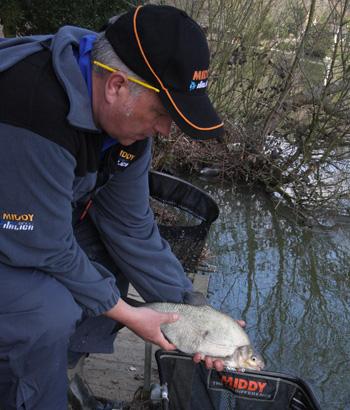 Despite an early start it was already a bright and warm morning when I arrived at Bury Hill to catch up with Russ to be greeted firstly by fishery owner David deVere. David and I go back a good few years and it was interesting to hear his side of the story in relation to the future of the fishery, which has been the subject of much speculation in some areas of the press in recent months.
Despite an early start it was already a bright and warm morning when I arrived at Bury Hill to catch up with Russ to be greeted firstly by fishery owner David deVere. David and I go back a good few years and it was interesting to hear his side of the story in relation to the future of the fishery, which has been the subject of much speculation in some areas of the press in recent months.
It was interesting to hear too that the Old Lake, where Russ would be fishing today, had recently received a stocking of prime bream averaging 4 to 6lb in weight, with the best fish a cracker of 14lb. I didn’t expect to see anything of that size come to the net today but I had a feeling Russ would get amongst a fish or two, he usually does!
As I walked down the long bank to the swim where Russ was set up it was clear that even for an angler of Russ’ calibre it might be a struggle today as not only was it going to be bright and hot but it was also going to be still too, with hardly a ripple to stir the surface of the water; a sunny, flat calm is hardly ideal weather for bream! The transition between seasons can be a tough time for all species as the weather is rarely consistent, indeed there had been frosts at the fishery earlier in the week.
I found Russ plotted up in peg 38 and after the pleasantries were out of the way he explained that it was an area of the lake with a good track record for turning up silvers and that matches were often won with a decent weight of slabs from the area; it was easy to see why as it commanded a large expanse of open water and, just like their bigger cousins, even shoal-sized bream favour areas of open water well away from any bankside disturbance.
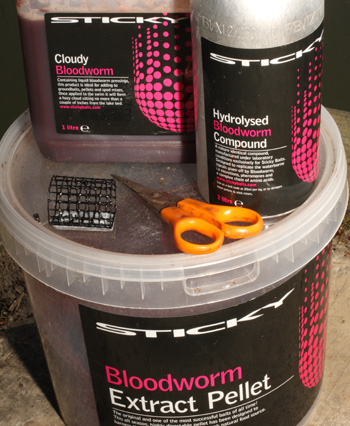 Russ pointed out that it wasn’t just a matter of looking to the open water though and on sunny, flat calms he always takes a very close look at the water for any signs of fish as bream are typically very good at giving their presence away, if not by the obvious and very typical rolling behaviour then by bubbling. Today, however, he hadn’t seen a single sign of activity and had been forced to rely on his knowledge of the lake.
Russ pointed out that it wasn’t just a matter of looking to the open water though and on sunny, flat calms he always takes a very close look at the water for any signs of fish as bream are typically very good at giving their presence away, if not by the obvious and very typical rolling behaviour then by bubbling. Today, however, he hadn’t seen a single sign of activity and had been forced to rely on his knowledge of the lake.
I pulled up my seat, poured a coffee from my flask and watched as Russ got to work.
Russ started off by putting his groundbait mix together, a mix comprising Lake Magic and SwimStim Green mixed with lake water and a little Sticky Baits Cloudy Bloodworm additive, the latter creating a hazy cloud of bloodworm extract which hovers just above the lake bed. To the mix Russ added some micro bloodworm pellets, softened Skretting pellets and some hookbait samples in the shape of live and dead red maggots and a few grains of corn.
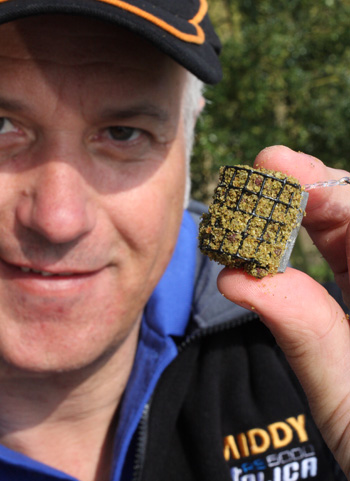 Russ started off casting a large 28g cage feeder every five minutes to get a bit of feed in the swim and then switched to a smaller model after an hour.
Russ started off casting a large 28g cage feeder every five minutes to get a bit of feed in the swim and then switched to a smaller model after an hour.
“It’s typical to have to work at building a swim with bream” Russ explained, “At this stage I’m looking for the odd liner, which is always encouraging, but what I don’t want to do is find the bream straight away and catch one from the off as this can really spook them.”
Tackle-wise Russ was employing a Middy 4G distance feeder rod with 4.4lb (0.14mm) Low-Viz line to a size 16 hook. As far as hookbaits were concerned he was going to vary between three dead red maggots, a couple of live maggots and sweetcorn, the latter often the bait with which to pick up the slightly better fish.
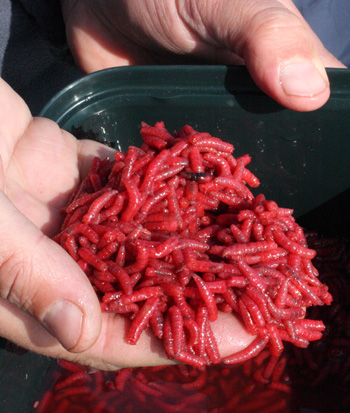 The dead maggots had been killed by freezing them for 24 hours and Russ had boosted their attraction by freezing hydrolysed bloodworm extract into them; “The main advantage deads offer over live,” he explained, “is that they don’t roll over the hook as live ones often do and result in bumped fish. You’ve got to make sure you freeze them for at least 24 hours though – I’ve had them come back to life before now!”
The dead maggots had been killed by freezing them for 24 hours and Russ had boosted their attraction by freezing hydrolysed bloodworm extract into them; “The main advantage deads offer over live,” he explained, “is that they don’t roll over the hook as live ones often do and result in bumped fish. You’ve got to make sure you freeze them for at least 24 hours though – I’ve had them come back to life before now!”
The only other bait Russ had with him for the session was a pot of mini boilies and every so often he would fire one or two into the swim. “The bream love them!” he said, “So I’m putting a few out but I’m not certain I’ll use one on the hook today as they seem to fish best a little later in the season, the same is true with pellets as well, they are great bream baits but they don’t score well early on.”
 Russ continued: “The one traditional bream bait I’ve not got with me today is worm. Bream LOVE worm and I use it just about everywhere I fish for them but for some reason here at Bury Hill it just doesn’t seem to work for them!”
Russ continued: “The one traditional bream bait I’ve not got with me today is worm. Bream LOVE worm and I use it just about everywhere I fish for them but for some reason here at Bury Hill it just doesn’t seem to work for them!”
It took over an hour for the tip to pull around for the first time and Russ netted the first fish of the morning, hopefully it was a sign that the fish were starting to move in but he was a little worried that he was not getting any line bites and that there were no signs of fish in the swim.
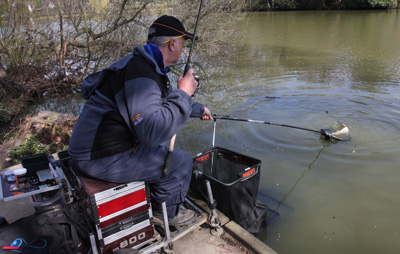 “Bream being bream.” He said, “they could turn up any time and given the number of them in the lake they are always on the move and they do usually turn up eventually!”
“Bream being bream.” He said, “they could turn up any time and given the number of them in the lake they are always on the move and they do usually turn up eventually!”
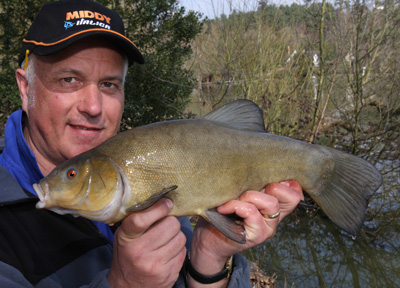 A switch to corn brought another fish before the swim went quiet again and Russ started to search out the peg by dropping the next cast shorter – to no avail.
A switch to corn brought another fish before the swim went quiet again and Russ started to search out the peg by dropping the next cast shorter – to no avail.
A much longer cast, right to the back of the swim, brought a missed bite and then a fish on the next cast to the same area. “It’s strange,” he said, “they appear to be out there but sitting off the feed and not moving onto it.” The next cast brought a nice bonus in the shape of a tench before the bites on the longer line dried up too and Russ dropped back onto the main feed area.
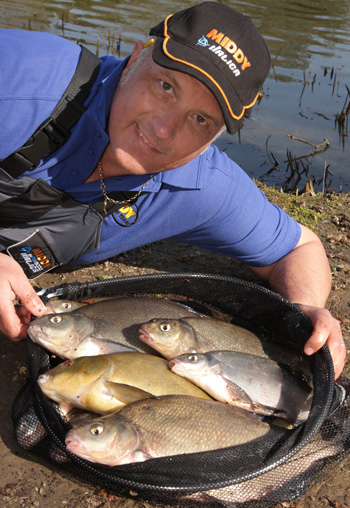
The pattern continued for the next hour or so with Russ really having to work to keep in touch with the fish and anyone who thought that bream fishing was simply a case of piling in the feed and sitting back on it waiting for the fish to arrive would have had their eyes opened today.
By lunchtime Russ had put together a decent net of fish in far from ideal conditions; it was a real case of grafting to a result and searching out the swim to get the most from it. Bream, it appears, can be just as contrary as any fish when they have a mind to it.










